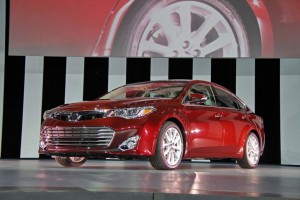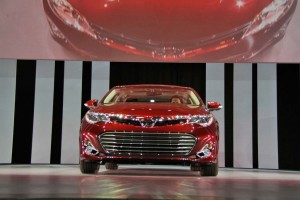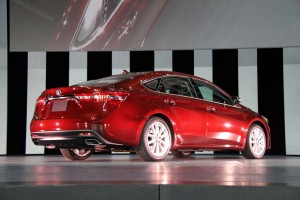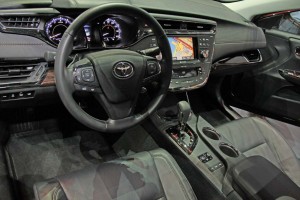It was one of the big mysteries of the 2012 New York Auto Show: what would Toyota name the new full-size sedan it planned to unveil during the annual show’s press days? Ultimately, it was no surprise at all. The new car will stick with an old, familiar nameplate: Avalon. But there all similarities end.
Toyota has long been known for quality, value and reliability — or QVR, in industry terms – but when it comes to design and driving dynamics, well, think plain vanilla. But times are changing. The original design for the 2012 Camry was panned by Toyota dealers and even after making some major changes the midsize model took plenty of critical hits. So, when it came time to re-do the brand’s flagship, then-new Toyota Motor Co. CEO Akio Toyoda encouraged a dramatic change.
He got it. The 2013 Toyota Avalonhas an elegant yet edgy shape that will clearly surprise Toyota loyalists – as well as its critics. Initial reaction following its unveiling at New York’s Jacob Javits Convention Center has been almost universally positive.
“This is the first vehicle in Toyota’s line-up to have Akio Toyoda’s thumbprint on it,” said Toyota Division General Manager Bob Carter, following the maker’s news conference.
The dramatic improvement in styling reflects some major changes in the way Toyota is doing business, these days. For decades, virtually everything was run out of Japan, so products often that camel-like quality that comes from relying on too many committees – and too little input from the market where Toyota products were actually being sold.
After taking the helm at the company started by his grandfather, Toyoda began arguing for more “passionate” products. And his campaign got an unlikely nudge when Toyota became embroiled in the sudden acceleration scandal, in late 2009. Slapped with record fines for delaying mandated recalls it promised to shift to a more localized management system.
In hindsight, says Carter, “That allowed us to build the car we wanted” for the U.S.
In fact, the vehicle was entirely styled and engineered in the States, much of the work being done at a new R&D center in the Detroit suburb of Ann Arbor, with additional styling handled by the maker’s advanced design center in Southern California.
And Toyota plans to build the new Avalon at its plant in Kentucky – notably, with about 90% of its componentry sourced in the United States.
The 2013 Toyota Avalon has a wider, more aggressive stance, with a European style nose that actually looks a bit like the new Ford Fusion – which, in turn, is very much in the mold of Europe’s supercar maker Aston Martin. The new Avalon has a long cabin with a coupe-like roofline that is vaguely reminiscent of the well-reviewed Audi A7,
The interior, meanwhile, adopts an almost luxury-class level of refinement, with upgraded leather that will now be hand-stitched to ensure a visual sense of craftsmanship, according to Toyota. The large touchscreen adapts the latest version of Toyota’s EnTune infotainment system and the LCD screen atop the center stack replaces most traditional knobs and buttons. The rest migrate to a capacitive system that can be operated with barely a touch.
There’s an elegant use of ambient lighting that makes it easy to find things inside the vehicle while not distracting the driver. Paddle shifters are built into the leather-wrapped steering wheel.
With a 111-inch wheelbase this is no small car, but Toyota officials are promising to get mileage that might, in the past, have been associated with a vehicle a good class size smaller. They hint about a hyper-efficient V-6 but won’t release powertrain details – which very well may also include a hybrid – until later in the year.
Significantly, the new Avalon will feature a Sport mode intended to offer more aggressive driving dynamics, “striking a balance between engaging performance and comfortable on-road motoring,” said Carter.
As might be expected, the new Toyota flagship will be loaded with high-tech safety features that include 10 airbag, Blind Spot Monitoring, Pre-Collision Warning, Cross-Traffic Alert and more.
Though American motorists may be downsizing as fuel prices soars towards record levels, Toyota remains confident it can increase demand for the new Avalon, if nothing else capturing buyers returning from light trucks to passenger cars.
Meanwhile, the maker believes the more exciting new design will help it win over the younger buyers that have, in recent years, largely ignored the Toyota brand. The maker has some indication it can reach that broader audience, the sportiest version of the 2012 Camry, the SE, seeing the age of its average buyer drop by about a decade compared to the previous offering.
If there’s one place Toyota played it safe with the 2013 Avalon it’s with the name. The maker had signaled it was seriously considering an alternative moniker – a common practice for automakers planning dramatic changes to an old product line.
But, in the end, planners recognized, “it is very difficult to introduce a new nameplate in the market today,” explained Carter, adding that it might have taken at least $100 million in additional ad revenues “just to get started” building recognition for a new brand name in today’s crowded market.
That includes a number of new competitors in the large car segment, including 2013 updates of the Chevrolet Impala and the Hyundai Azera. Toyota will need a more passionate pitch to maintain its momentum with the Avalon.





3rd paragraph: “2013 Toyota Camry” should read “2013 Toyota Avalon”…
WLB :>)